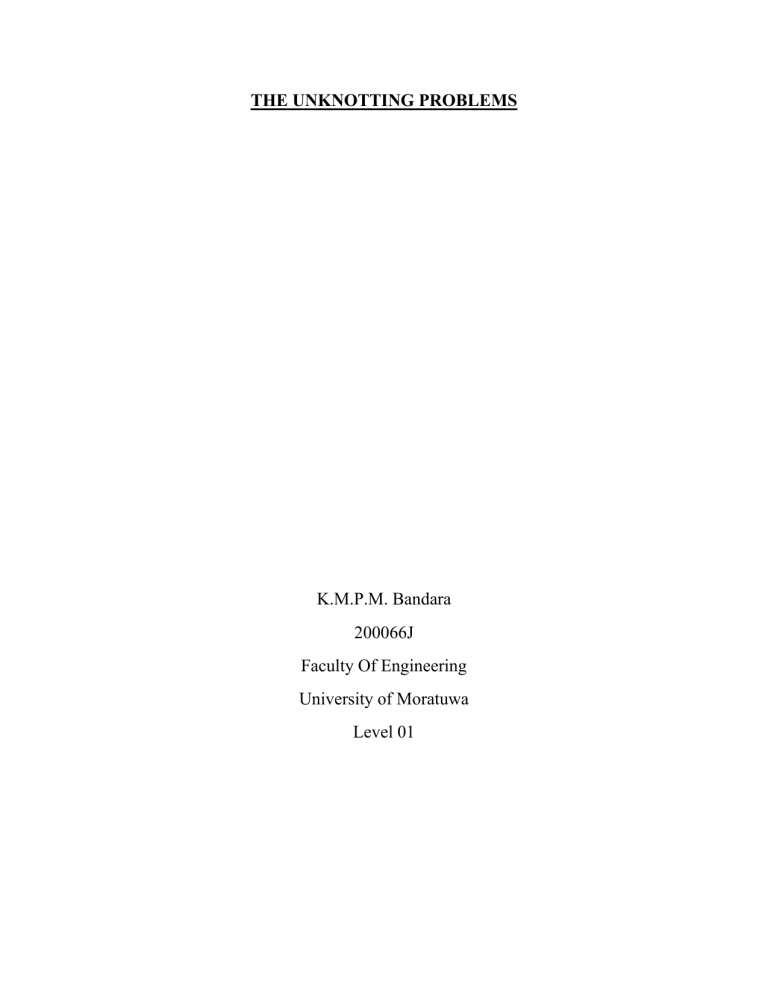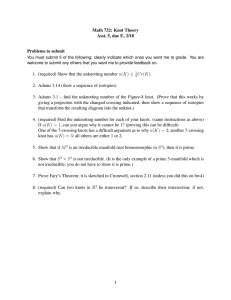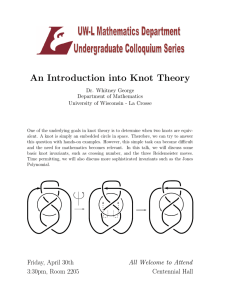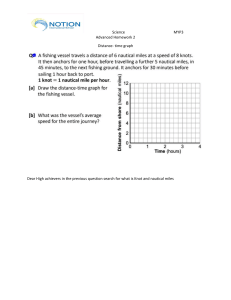
THE UNKNOTTING PROBLEMS K.M.P.M. Bandara 200066J Faculty Of Engineering University of Moratuwa Level 01 THE UNKNOTTING PROBLEMS Introduction There are some hardest mathematics problems that remain in the world unsolved. Some of them are, The Collatz Conjecture Goldbach’s Conjecture The Twin Prime Conjecture The Riemann Hypothesis The Birch and Swinnerton-Dyer Conjecture The Kissing Number Problem The Unknotting Problem The Large Cardinal Project As you can see, the unknotting problem is one of them. Figure 1 Examples (source; Popular Mechanics) The Unknotting Problem's most basic version has been solved. As an example, Lisa Piccirillo, a mathematician at the University of Texas at Austin, learned about the Conway knot (“a knot with 11 crossings, so named for the late mathematician John Horton Conway” (Delbert, 2020)) from a colleague's talk at a conference. She solved it within a week. Figure 2 Conway knot (Source; Generated by knotilus website (http://knotilus.math.uwo.ca/) and rendered by POV-Ray) If someone develops an algorithm that can unknot any knot in what is known as polynomial time, the Unknotting Problem will be solved. What is a knot? A knot is a fastening made by looping a piece of string, rope, or something similar on itself and tightening it. Its in a 3-dimentional space. Figure 3 Examples of different knots (source; collection of Matemateca IME-USP) Knot theory To learn about mathematical knots, we use knot theory. However, as a starting point for a study of knot mathematics, we must excoriate this aesthetic layer and focus on the knot's shape. In essence, knot theory is the study of the geometrical aspects of these shapes (Murasugi, 2007) . A mathematical knot is distinct from regular knots found in shoelaces and rope. The ends of a mathematical knot are joined together so that it cannot be undone. The ring knot is the most basic. To describe a knot, we can use a planar diagram known as a knot diagram. We use knot theory in Biology to examine the folding of DNA. The unknotting problem The problem of algorithmically recognizing the unknot given some representation of a knot is known as the unknotting problem. There are various kinds of unknotting algorithms. Haken (Wolfgang Haken, born June 21, 1928) discovered the first solution to the unknotting problem in 1961. His plan was to divide Euclidean space into many small tetrahedra, with the knot made up of some of their edges. Then one looks for a triangle union that forms a disk with the knot as its boundary. A disk of this type exists if and only if the knot is the unknot (Manolescu, 2012). Figure 4 Two simple diagrams of the unknot (source; AxelBoldt at English Wikipedia) There are some other unknotting algorithms such as Hass-Langris (2001), Birman-Hirsch (1998), Dynnikov (2002) etc. As mentioned by Nash & Th. Rassias (2016) several unknotting algorithms are based on Haken's theory of normal surfaces. Haken's algorithm uses the theory of normal surfaces to find a disk whose boundary is the knot. Haken originally used this algorithm to show that unknotting is decidable but did not analyze its complexity in more detail. Haken’s algorithm employs normal surface theory to locate a disk whose boundary is the knot. Haken originally used this algorithm to demonstrate that unknotting is decidable, but he did not investigate its complexity in depth. Haken's algorithm uses the theory of normal surfaces to find a disk whose boundary is the knot. Haken originally used this algorithm to show that unknotting is decidable but did not analyze its complexity in more detail. Hass, Lagarias, and Pippenger demonstrated that the set of all normal surfaces can be represented by integer points in a polyhedral cone, and that a surface witnessing the unknotted Ness of a curve (if it exists) can always be found on one of this cone's extreme rays. Haken's algorithm uses the theory of normal surfaces to find a disk whose boundary is the knot. Haken originally used this algorithm to show that unknotting is decidable but did not analyze its complexity in more detail. Birman and Hirsch's algorithm employs braid foliations, which are a slightly different type of structure than a normal surface. However, in order to analyze its behavior, they return to standard surface theory. An invariant that detects the unknot would be a more conceptual solution. Some knots are distinguished by their 3-colorability. However, many non-trivial knots are not 3-colorable.


